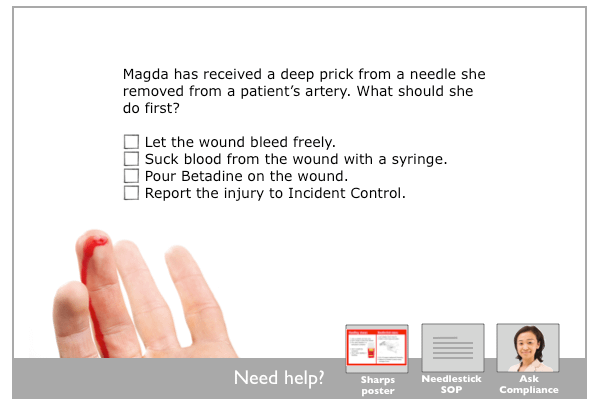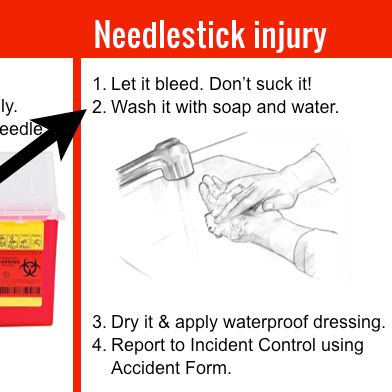By Cathy Moore
Often we're told, "Put this information into a course." But what happens if we put the information into a job aid instead, and then design mini-scenarios that help learners use the job aid?
This approach not only keeps boring blather out of our elearning, it can also make our activities more memorable. Here's how it could work.
Elearning example
Let's say we're designing training about needle safety for a hospital. A common approach would be to display some slides of information about dos and don'ts, and then to present a generic fact check, like, "What's the best way to dispose of a used needle?"
Instead, we'll plunge our learners directly into an activity that somewhat simulates real life and that includes real-life job aids. So here's the first thing learners see.

We're tempting the learner to respond without thinking, but we've also given them access to more information. For example, the learner could click the first thumbnail to see the safety poster that appears in every examining room and that explains what to do with a needlestick injury.
But our sample learner thinks, "Everyone knows you pour Betadine on that kind of wound," and they choose that without looking at any other information.
Here's the feedback we give them.

The feedback describes the results of the learner's choice, letting the learner conclude that they were wrong. It also includes a snippet of the safety poster, pointing out where the learner should have looked. The learner sees for themselves that they not only skipped a step, they also used the wrong washing method.
Why did we do this?
Even though the safety poster appears in every room, we suspect that people aren't looking at it, because they're making basic mistakes with needles. So our course not only corrects the common mistakes but repeatedly reminds learners of the job aids they should be using.
And, importantly, this approach lets us surprise learners with their own mistakes. If we first listed a bunch of rules, including "Wash needlestick injuries with soap and water," the learner might be mildly surprised, thinking, "What, not Betadine?" But by letting the learner give Magda Hepatitis C, we've surprised them more vividly and, ideally, will help them remember their mistake the next time they accidentally jab themselves.
This is a very simple demonstration of how we can have learners practice using job aids. For more complex procedures, we could have learners refer to the job aid as they carry out each step, showing the results of each decision in a realistic way.
Scenario design toolkit now available
Design challenging scenarios your learners love
- Get the insight you need from the subject matter expert
- Create mini-scenarios and branching scenarios for any format (live or elearning)
It's not just another course!
- Self-paced toolkit, no scheduling hassles
- Interactive decision tools you'll use on your job
- Far more in depth than a live course -- let's really geek out on scenarios!
- Use it to make decisions for any project, with lifetime access










Nicely done. Sounds like it was lifted right out of the Heath Brothers’ Made to Stick.
I’m always looking for ways to get in the learners’ faces early (engages them rapidly) and to provide them with clever ways they need to use things like job aids to do their jobs correctly.
I also like your focus on “doing” and not “knowing”. After all, “knowing” is implicit in “doing,” but “doing” is what will appeal not only to adult learners but to any external assessment that seeks to determine if what was supposed to be learned was actually learned.
The trick, I find, is to elicit from your customers the behaviors that the learner will be engaged in when applying the knowledge they want you to convey.
Nicely done.
This is great, Cathy. I find myself always wanting to use min-scenarios like this these days (if I can talk client’s into it). Another super advantage, as you know, is that it promotes higher level thinking skills rather than rote memorization. Love your stuff!
Connie
This is very interesting! Scenarios that stick in the mind are such powerful learning tools, and it’s funny to think how often we ignore the explicit instruction or aids that are readily available to us (like the safety poster) in this type of situation. This really is an engaging way of learning. Great stuff!
Great article! I am a big fan of your work, can you reccomend some books to get inspired for more meaningul learning experiences?
I liked Michael Allen’s Guide to Elearning, which I think has been updated since I bought it. The other books I own are more about how to use media to teach efficiently or how to do performance consulting; they’re not really about how to design emotionally compelling activities. I’m sure there are good books out there. Can anyone else recommend any books that help create more meaningful learning?
Another great post!
This technique is also useful to link users to ontime solutions where data might be transient or subject to change from time to time.
For me, where eLearning modules often fail is that the eLearning module tries to be an all encompassing self-contained module. Which is great…. until something is changed and then the module becomes quickly out-of-date (think Financial Services, Construction, Mining etc).
Job Aids and ontime learning tools allow key information that is subject to change to be located outside the eLearn module so that the module remains up-to-date for longer periods of time. And, as Cathy points out, to encourage them to actually use the tools available to them on job.
Cathy,
What an excellent post. Great examples and it really does an excellent job of describing how to accomplish the mini-scenario with ease. As always you rock. Thanks so much for yet another wonderful contribution to the community.
Love this. Thank you so much; I have been struggling with how to do scenarios without a long drawn-out development/production timeline. This is perfect. Thanks again!
Agree. This is simple and effective. And thanks for the example – it’s an excellent one for explaining the concept of mini-scenarios.
//Anders
As mentioned in the post, I gave a one-hour online workshop on scenario design for the E-learning Network of Australasia. You can now see the recording here. The workshop introduces a three-part formula for designing engaging scenarios and emphasizes basing your material on scenarios, rather than tacking them on to an information presentation.
Hi Cathy,
I’m a budding Instructional Designer and you’re input is really inspirational! Thank you very much for sharing it with us all! ‘Inspiration begets inspiration’
As usual, another great contribution, Cathy. Thank you so much for sharing so valuable ideas. I will try to use this concept in a new e-learning course on Harrassment I was told to develop.Thanks again!
The idea of creating “mini-scenarios” is very appealing to me. As a nurse educator I was especially attracted to your subject of needlestick injuries in a hospital. This is a topic near and dear to me as both a health care professional at risk and an educator. The idea of short steps in learning is very appealing for busy workers in the hospital setting. The topic hits home to most who work there as needlesticks are all too often a hazzard of that environment. Workers can stay informed without being bombarded with cumbersome reading. Pictures appeal to the visual learner as well. Great job….great idea. Plan to use it in my development of educational programs.
Hello. I am applying this concept hoping that the software, standards folks, etc will permit it. This departs from the accepted templates, about which everyone complains, but deviating from them is frowned upon. One item we will not be able to avoid is the scored test. Any recommendations regarding what sorts of testing to apply in a mini-scenario situation?
Rick, thanks for your question. I recommend using the same mini-scenario questions in the test, with the only difference being that the feedback doesn’t include additional info that points them toward the correct answer. If learners aren’t expected to memorize everything and are supposed to use job aids, as in the example shown in the post, then it seems fair to include the job aids in the question. While some stakeholders might object to this, if learners are allowed or expected to access the aids on the job, then including them in the test is realistic.
This is really wonderful. Thanks a lot for sharing:-)
Cathy- do you include a course overview or introduction before the activities? I like starting with something to grab their attention, however when do you include info about the course?
Thanks for your question. Usually, most people who are taking a course know what it’s about because they’ve been assigned it or have chosen it from a list of courses, and it has a title like “Infection control.” So usually I think we don’t need much or any introduction, and that we can get by with a *very short* list of what people will be able to do as a result of the course, something like “This course will help you protect yourself and others from the common mistakes that can cause serious illnesses. X people became seriously ill and Y people died last year in [our hospital / our country] due to these common mistakes.” I’d then design an opening scenario that tempts people to commit one of the common mistakes and see the bad consequences of it, which should do a good job of grabbing their attention.
Another approach is to use an opening story to dramatize the need for training. This runs the risk of slowing down the pace a lot. For a high-quality but in my opinion slightly slow and non-interactive example, see “Partnering to Heal” at this site: http://willinteractive.com/demos/partnering-to-heal/.